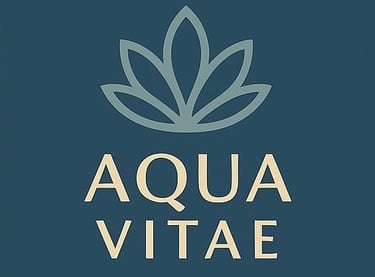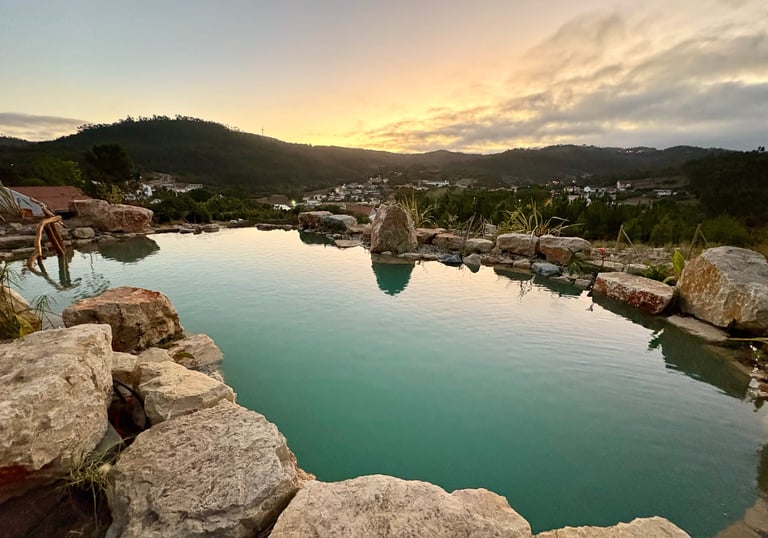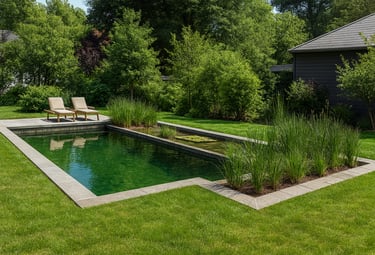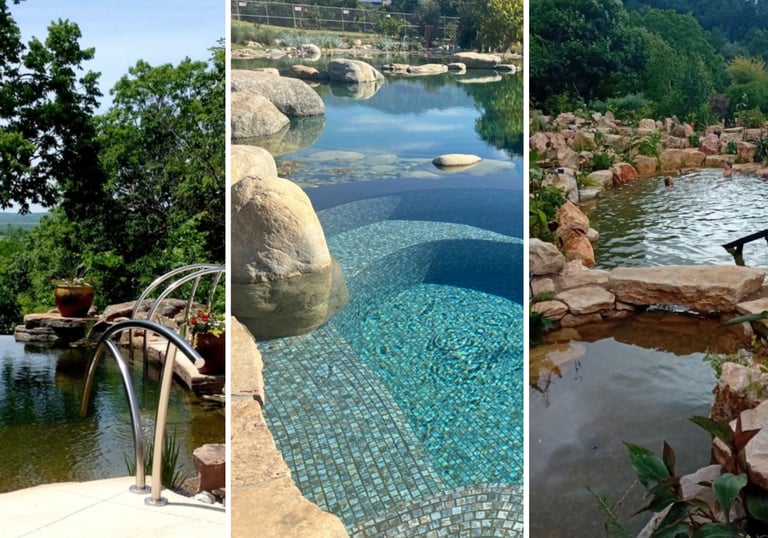How to Convert a Chlorine or Salt Pool to a Natural Pool | Aqua Vitae Guide
Step-by-step guide to transforming a chemical chlorine or saltwater pool into a natural swimming pool. Learn the equipment, filtration, and plant system used by Aqua Vitae to create clear, living water — without chemicals.
8/18/20254 min read
How to Convert a Chlorine or Salt Pool to a Natural Pool
A practical step-by-step guide to transforming an existing chemical pool into a living, chemical-free natural swimming environment.
Converting a traditional chlorine or saltwater pool into a natural swimming pool—also called a biopool or living pool—is more achievable than most homeowners realize. By combining modern filtration technology with biological plant systems, an existing chemical pool can be re-engineered to sustain crystal-clear, chemical-free water. This guide outlines the key planning steps, equipment options, and conversion processes used by Aqua Vitae Natural Pools in professional retrofits.
What’s the Difference Between Natural, Saltwater & Chlorine Pools
Before beginning the conversion, assess the pool’s structure, hydraulics, and environment.
A sound concrete or lined shell is essential, as is good circulation. Review the existing pump, filter, and plumbing for compatibility with low-pressure, continuous flow systems. Consider site factors—sun exposure, leaf load, and bather usage—to determine the filtration size and whether you’ll need a compact converter unit or a full regeneration zone with aquatic planting. There are also online apps that can help calculate all this.


Planning & Suitability
A. Regeneration-Zone Conversion (Plant-Based)
This method creates a planted wetland (regeneration zone) connected hydraulically to the main swim basin. Water flows through graded gravel and aquatic plants that biologically filter and oxygenate the system. It offers unmatched ecological balance and visual appeal but requires adequate space.
B. Converter-Module Conversion (Compact System)
Here, the existing skimmer–pump–filter circuit is retained and upgraded with a biological chamber, phosphate-removal stage, and UV-C sterilization. Chlorine generation is disabled, and the system relies on continuous low-energy circulation. This compact method is ideal when footprint or structural modification options are limited.
C. Hybrid Conversion (Plants + Compact Bio-Filtration)
This approach blends the natural beauty and biological function of a planted regeneration zone with the efficiency and footprint-savings of a compact converter system. Ideal for clients who want plants but don’t have the 30–40% area typically required for a full regeneration zone. A smaller planted section is installed, and the remaining filtration demand is handled by a compact bio-filter module, ensuring excellent water quality with greater flexibility in design.
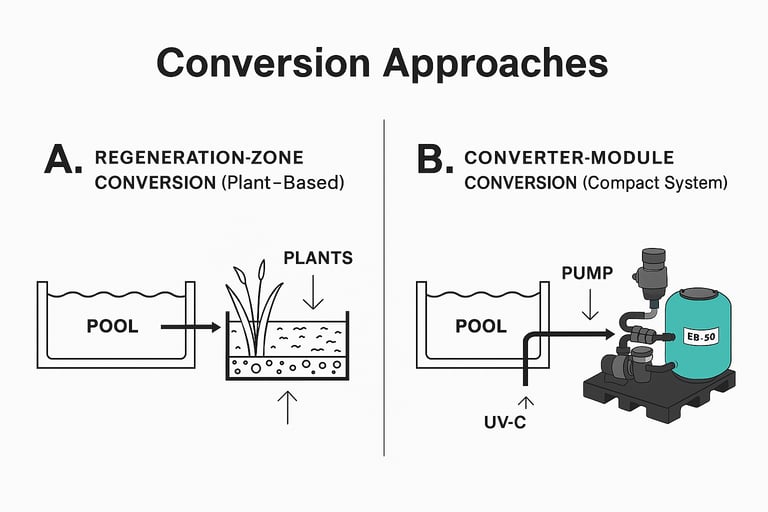

Conversion Approaches
Reliable, continuous circulation is vital for clarity and biological health.
Most conversions use a variable-speed pump, bead or glass-media filter, UV-C sterilizer, and an optional phosphate filter. Plant-based systems add a gravel regeneration bed where microorganisms and roots polish the water naturally.
If space is tight, a modular converter can achieve similar results using mechanical filtration and bio-media instead of planted zones.
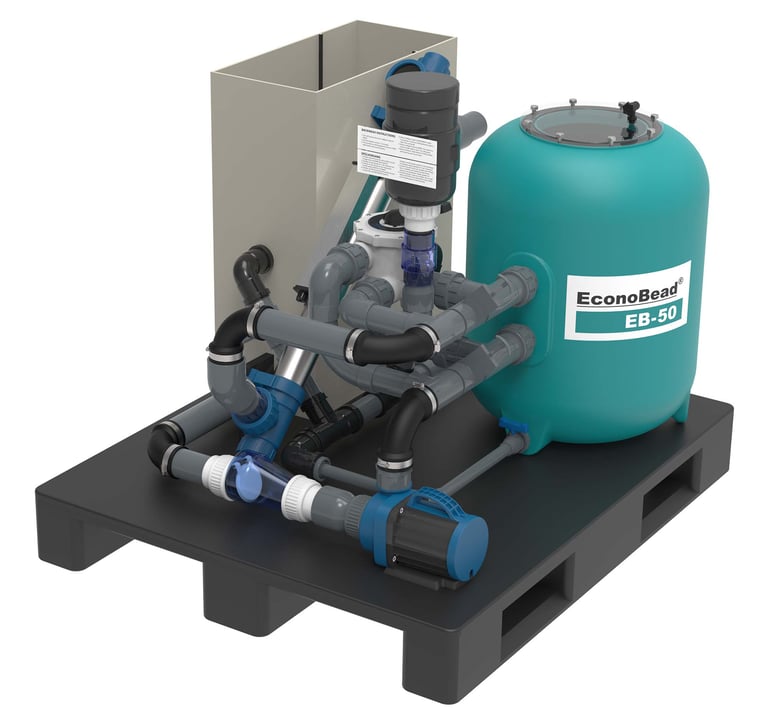

Equipment & Circulation
Media & Planting
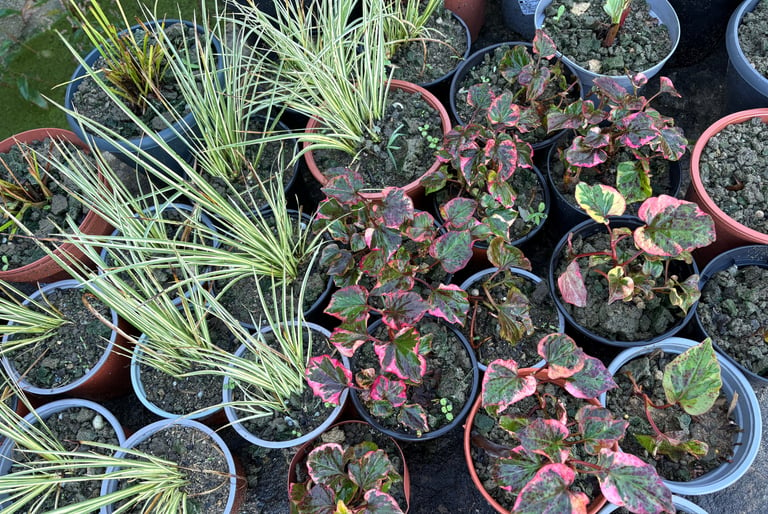

For regeneration zones, use layered stone media—typically 20–40 mm base drainage, 8–16 mm filter layer, and 2–8 mm top layer. Avoid fine sands that clog.
Select native or climate-tolerant species such as hornwort, iris, rush, and lilies or lotus. These plants oxygenate the water, stabilize nutrients, and create a balanced ecosystem that supports long-term clarity.
Beyond filtration, adding plants introduces much-needed color, texture, and foliage to traditional pools. Even a small planted zone or perimeter planter softens harsh concrete lines, blends the pool into its natural surroundings, and transforms a sterile blue basin into a vibrant, living landscape element.
Deactivate the chlorine system. Disconnect or isolate salt cells or chlorinators, and let residual chlorine dissipate.
Clean and inspect. Remove scaling, biofilm, and debris; repair cracks or leaks.
Reconfigure hydraulics. Connect the pump → prefilter → mechanical filter → UV-C → biological or phosphate filter → returns.
Install the new filtration components. Whether a converter module or a planted wetland, ensure even water distribution and easy maintenance access.
Add plants and fill the system. Introduce aquatic plants carefully, using potable water and avoiding turbulence that uproots young roots.
Start continuous circulation. Let the system run 24/7 during early stabilization (typically 6–10 weeks). Expect some natural algae bloom before biological balance sets in.
Step-by-Step Conversion Workflow
Maintenance & Operation
Run the pump continuously during the swimming season and reduce speed only in cooler months—never let the system stagnate.
Backwash mechanical filters as needed, replace UV-C lamps annually, and trim aquatic vegetation seasonally.
Keep phosphate levels below 0.03 mg/L to prevent algae growth.
A well-maintained system stays clear year-round with minimal intervention.
Safety & Local Compliance
Check local regulations before converting, as some municipalities classify natural pools differently than chlorinated ones.
Maintain safe steps, grab rails, and non-slip entry zones.
If diving features are included, confirm minimum depth clearance and safety labeling.
Aqua Vitae Approach
At Aqua Vitae, we combine the best of both systems: compact biological and phosphate filtration modules paired with UV-C and bead filters, and, when space allows, a planted regeneration zone.
This hybrid design ensures fast start-up, low maintenance, and the living water clarity that defines every Aqua Vitae Natural Pool.
You may also like...
Top Natural Pool Builders in Portugal: How to Choose the Right Expert | Aqua Vitae Guide
Looking to build a natural swimming pool in Portugal? Discover the leading companies, their specialties, and how to choose the right builder for your vision. Learn what sets Aqua Vitae apart.
Why Most Natural Pools Don’t Look Natural | Aqua Vitae Guide
Many natural pools miss the mark. Discover why — and how Aqua Vitae designs truly naturalistic pools using a method refined over 25 years.
Explore styles and various features for creating your dream natural pool, pond or water‑feature. From design inspiration to filtration, plants and aesthetic detail.
Design Your Dream Natural Pool – Styles & Features | Aqua Vitae Guide
Experience the future of swimming with natural pools.
© 2025 Aqua Vitae. All rights reserved.
